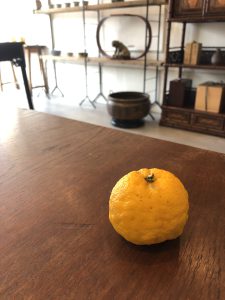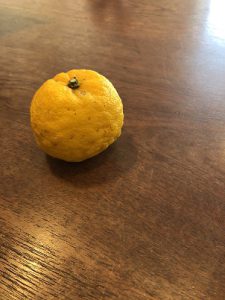ゆずをいただきました。うれしい。(愛知県名古屋市千種区姫池通 骨董買取 古美術風光舎)
2021.12.22
みなさま、こんにちはスタッフYです。
本日は、ブログを綴っているわたくしの隣に、黄色いゲストが。

なんと先日、お友達から柚子をいただきました。買わねばと思っていた矢先でしたので、本当に嬉しい。このぼこぼことしたフォルム、眺めておりますと、けっして美人さんではないがたくましく育っておるではないかと、ほほえましくもなってまいります。
さてさて、本日は冬至。
一年を通して、暦上の行事をを追いかけながら生活しているようではありますが、みなさま一年の暦行事の終盤、冬至まできました。この一年、お疲れさまでした。
日本には四季があるお陰でしょうか、わたくしはこれらの暦の行事をよく「色彩」としてイメージづけております。本日の冬至は、黄色といいましょうかそのまま「ゆず色」。これにカボチャの黄色が加わり、そのまんまではありますが冬至はあたたかな黄色のイメージでして、この黄色が一年の疲れを癒し包んでくれる色ともイメージつけております。
さてさて冬至はご存じの通り「二十四節気(にじゅうしせっき)」の一つで、1年で最も昼が短く、夜が長い日のこと。今年は本日の2021年12月22日(水)が冬至にあたります。
冬至は「太陽の偉大なエネルギーが復活する日」であり、「一陽来復(いちようらいふく)」とも言われており、この日は太陽が復活する日として、全国各地で盛大な「冬至祭」が行なわれる日でもあります。太古の昔、太陽が一番弱まる日と考えられ、日の力を鎮魂させまた復活させる日でもありました。
旧暦の冬至は、霜月(しもつき、11月)にあたり、11月15日頃でしたので、宮中では、11月の下の「卯の日」(三卯の月には中の卯、新暦採用後は11月23日)の新嘗祭(にいなめさい)の前日の「寅の日」に、鎮魂祭が行われでおります。
そんな冬至、かぼちゃを食べ、柚子湯に入る日として知られていますが、もちろん昔からの意味がございます。
かぼちゃを食べるのは、冬至を1年の締めくくりの日ととらえ、「いろはにほへと」の最後にあたる「ん」の付くものを食べるのが良いという縁起担ぎなのですが、その中でも、「かぼちゃ(南瓜:なんきん)」「人参(にんじん)」「蓮根(れんこん)」「銀杏(ぎんなん)」「金柑(きんかん)」「寒天(かんてん)」「うんどん(うどん)」の「ん」が重なる食べ物は、「冬至の七種(ななくさ)」と呼ばれ、特に縁起が良いとされるところからきているようです。
それでは、冬至に柚子湯に入ることは?
柚子湯の起源は明らかではないのですが、日本では、冬至の日に柚子湯に入ると「風邪をひかずに冬を越せる」と言われていますが、柚子湯に入る習慣は、意外に新しく、銭湯ができた江戸時代から始まったと言われています。
天保9(1838)年に刊行された、近世後期の江戸と江戸近郊の年中行事を月順に解説した『東都歳時記』(斎藤月岑(さいとう げつしん)編)には、「11月に冬至。星祭。今日諸人餅を製し、家人奴僕にも与えて陽復を賀す。又来年の略暦を封じて守とす。今日、銭湯風呂屋にて柚湯を焚く」と、書かれており、5月5日の「端午の節句」の菖蒲湯も同様で、現在も街の銭湯に受け継がれております。
はたまた、柚子(ゆず)=「融通がきく」、冬至=「湯治(とうじ)」。こうした語呂合せから、冬至の日に柚子湯に入ると言われていますが、もともとは「一陽来復」の運を呼びこむ前に、厄払いするための禊(みそぎ)だと考えられております。現代でも、新年や大切な儀式に際して入浴する風習がありますよね。それらと同じような意味合いのようです。
それに加え、柚子自体香りも強く、邪気を祓うという俗信もあり、また柚子は実るまでに長い年月がかかるので、「長年の苦労が実りますように」との願いも込められているようですので、いろいろな意味を含めて柚子なのでしょうね。
ですが先日の茶柱と同じように、江戸時代に銭湯にて客寄せのためのマーケティング戦略もあったようで。冬至の日に柚子を入れたのが柚子湯が始まりと言われております。
現在では柚子の様々な効能が明らかになっており、柚子湯には血行を促進して冷え性を緩和したり、体を温めて風邪を予防したり、果皮に含まれるクエン酸やビタミンCによる美肌効果があると考えられております。柚子の果汁や果皮には多くの栄養が含まれており、お肌に良いと言われているビタミンCの含有量は柑橘類の中でもトップクラスであります。
柚子100g中に含まれる果汁のビタミンC含有量は40mgですが、果皮には150mgと特に多く含まれておr、ビタミンCは肌の保水性を高め、抗酸化作用を有することから、乾燥肌の予防や老化予防や肌を守るバリア機能の効果が期待できます。
その柚子湯は、柚子の果実を丸のままお湯に浮かべる光景がイメージされますが、柚子の薬効による様々な効果を得るためには、柚子を細かく刻んでさらしの袋に入れ、湯に浮かべるのがよいようです。この柚子入りの袋で体をこすると、柚子独特のよい香りの癒し効果とともに、肌を滑らかにする効果があるそうです。
それにしても、当時成分分析もしたわけでもないかつての先人が「柚子いいんじゃない?」と、いった感と戦略が妙にさえてるなと思ったり、そこにも関心したりいたしました。
そんな取り留めもないことを綴っておりましたら、机上の黄色の柚子からほんのりとした甘い香りが。
「そんな情報はどうでもよいぞ。とにかく香りを堪能してくれ。」と、いい具合にこの香りが私の頭の中のうんちくをサッとかき消して、ほんのりやさしく包んでくれました。
さ、今夜の柚子湯が楽しみでしょうがないですね。
それでは、ごきげんよう。

Hello everyone, this is Staff Y.
Today, next to me who is writing a blog, there is a yellow guest.
The other day, I got Yuzu from a friend. I was just about to buy it, so I’m really happy. When I look at this rugged form, I feel like I’m not a beautiful woman, but I’m growing up strong.
By the way, today is the winter solstice.
It seems that they are chasing calendar events throughout the year, but everyone has reached the end of the year’s calendar events, the winter solstice. Thank you for your hard work this year.
Perhaps because of the four seasons in Japan, I often imagine these calendar events as “colors.” Today’s winter solstice is yellow, or “Yuzu color” as it is. The yellow color of the pumpkin is added to this, and although there is a certain amount of it, the winter solstice has an image of a warm yellow color, and this yellow color is also an image that heals and wraps the tiredness of the year.
By the way, as you know, the winter solstice is one of the “24 solar terms”, which is the shortest day and the longest night of the year. This year, today, December 22, 2021 (Wednesday) is the winter solstice.
The winter solstice is “the day when the great energy of the sun is revived” and is also called “Ichiyo Raifuku”. It is also the day when the festival is held. In ancient times, it was thought that the sun was the weakest day, and it was also the day when the power of the sun was relieved and revived.
The winter sword of the lunar calendar was Shimotsuki (November), which was around November 15th, so in the palace, “Ura no Hi” under November (the middle Ura in the third month, adopted the new calendar). After that, the requiem festival is held on “Tora Day”, the day before the Niinamesai (November 23rd).
It is known as the day when you eat pumpkin and take a bath in Yuzu bath at the winter solstice, but of course it has a long-standing meaning.
Eating pumpkin is a good luck to think of winter as the last day of the year, and to eat the one with “n” at the end of “Irohanihoheto”. Among them, “Pumpkin (lotus root: Nankin)” ), “Carrot”, “Lotus root”, “Ginkgo nuts”, “Pumpkin”, “Agar”, “Udon”, and “N” overlap. It is called “Nanakusa” and seems to come from a place that is said to be particularly auspicious.
Then, how about going to Yuzu bath at the winter solstice?
The origin of Yuzu-yu is not clear, but in Japan, it is said that if you take Yuzu-yu on the day of the winter solstice, you can go through the winter without catching a cold. It is said that it started in the Edo period when a new public bath was created.
In “November”, “Toto Saijiki” (edited by Gesshin Saito), which explains the annual events of Edo and the suburbs of Edo in the latter half of the modern solstice in monthly order, was published in 1838. Winter solstice. Star festival. Today, people make rice cakes and give them to my family members to celebrate the sunshine. Also, I will seal the abbreviation of next year and protect it. The same is true for the iris bath of “Dano no Sekku” on May 5th, which is still inherited by the public baths in the city.
Also, Yuzu = “flexible”, winter solstice = “touji”. From these words, it is said that you will enter Yuzu-yu on the day of the winter solstice, but it was originally thought to be a misogi to get rid of bad luck before calling for the luck of “Ichiyo Raifu”. .. Even today, there is a custom of taking a bath during the New Year and important ceremonies. It seems to have a similar meaning to them.
In addition to that, Yuzu itself has a strong scent, and there is a popular belief that it exterminates evil spirits, and since it takes a long time for Yuzu to bear fruit, it seems that there is also a wish that “long years of hard work will be fruitful”. So, I think it’s Yuzu, including various meanings.
However, like the tea pillar the other day, it seems that there was a marketing strategy for attracting customers at public baths during the Edo period. It is said that Yuzu-yu started when Yuzu was added on the day of the winter solstice.
At present, various effects of yuzu have been clarified. Yuzu-to promotes blood circulation to relieve poor circulation, warms the body to prevent colds, and makes the skin beautiful with citric acid and vitamin C contained in the pericarp. It is believed to be effective. Yuzu juice and skin contain a lot of nutrients, and the content of vitamin C, which is said to be good for the skin, is one of the highest among citrus fruits.
The vitamin C content of fruit juice contained in 100 g of yuzu is 40 mg, but the skin contains a particularly large amount of 150 mg. Vitamin C enhances the water retention of the skin and has an antioxidant effect, so it can be expected to prevent dry skin and aging, and it can be expected to have a barrier function to protect the skin. You can imagine the scene, but in order to obtain various effects of the medicinal properties of Yuzu, it seems better to chop the Yuzu into small pieces, put it in a bleached bag, and float it in hot water. Rubbing your body with this bag containing yuzu is said to have the healing effect of a good scent unique to yuzu and the effect of smoothing the skin.
Even so, I thought that the “feeling” of the former ancestor, “Yuzu, isn’t it?”
If you spell out that there is no such thing, you can smell the slightly sweet scent from the yellow yuzu on the desk.
“I don’t care about that kind of information,” he said, erasing the poop in my head with this scent.
I’m looking forward to tonight’s Yuzu bath.
Well then, good luck.
**********************
このところのいよいよ寒くなって参りましたね。
生活様式の変化とともに、大切なお品を整理されている方も多いことと思われます。
ここ風光舎では、古美術品や骨董品の他にも絵画や宝石、趣味のお品など様々なジャンルのものを買受しております。
お片付けをされていて、こういうものでもいいのかしらと迷われているものでも、どうぞお気軽にご相談下さいませ。
風光舎は、出張買取も強化しております。
愛知県内はもちろん、岐阜県・三重県その他の県へも出張いたします。
どんなにご近所の方でもお伺いできますので、まずはお電話お待ちしております。
愛知県名古屋市千種区・骨董 買取
『古美術 風光舎 名古屋店』
TEL 052(734)8444
10:00-17:00 OPEN

